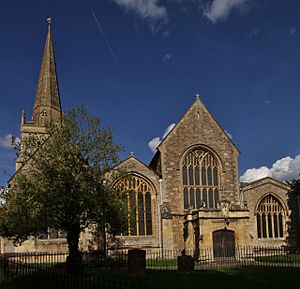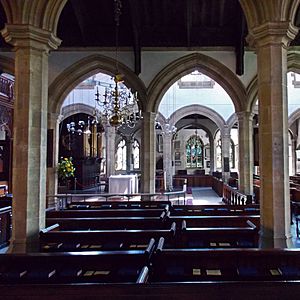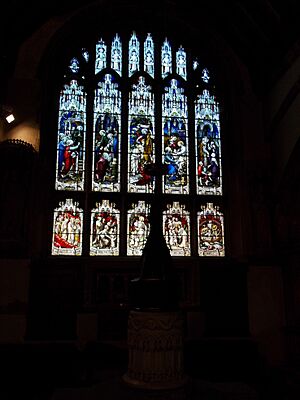St Helen's Church, Abingdon facts for kids
Quick facts for kids St Helen's Church |
|
|---|---|
| Parish church of Abingdon-on-Thames | |

spire (left) and west front
|
|
| 51°40′03″N 1°16′58″W / 51.6676°N 1.2829°W | |
| Location | Abingdon, Oxfordshire |
| Country | United Kingdom |
| Denomination | Church of England |
| History | |
| Status | church |
| Dedication | Saint Helen |
| Architecture | |
| Functional status | active |
| Heritage designation | Grade I listed |
| Designated | 19 January 1951 |
| Style | English Gothic |
| Years built | 13th–16th centuries |
| Specifications | |
| Number of spires | 1 |
| Materials | stone |
| Bells | 10 |
| Tenor bell weight | 0 long tons 16 cwt 0 qr (1,790 lb or 0.81 t) |
| Administration | |
| Parish | Abingdon-on-Thames |
| Diocese | Oxford |
| Province | Canterbury |
St Helen's Church is a historic Church of England parish church located in Abingdon, England. It sits right by the River Thames in Oxfordshire. People believe the church was built on the same spot where an old Anglo-Saxon nunnery, called Helenstowe, once stood.
Contents
The Church Building
The church's tall spire is a famous sight in Abingdon. The oldest parts of the church were built a very long time ago, in the late 1100s or early 1200s. Some of its windows are from the 1300s. The church was updated and changed quite a bit in the 1400s and 1500s.
Later, between 1869 and 1873, the church was carefully repaired and updated. This was done following plans by an architect named Henry Woodyer. He was known for his Gothic Revival style, which brought back older building designs.
Inside the church, you can see special painted panels on the ceiling of the north aisle. These paintings are from around 1390. They show something called the "Tree of Jesse," which is a picture of Jesus's family tree. St Helen's Church is considered a very important building. It is a Grade I listed building, which means it has special historical and architectural value.
Around the churchyard, there are three groups of almshouses. These were special homes built long ago for people who needed a place to live. The oldest ones are the Long Alley Almshouses, built in 1446. Then there are Twitty's Almshouses from 1707 and Brick Alley Almshouses from 1718. A famous expert on buildings, Nikolaus Pevsner, once said that no other churchyard has anything quite like them.
The Bells of St Helen's
The church has a northeast tower with ten bells that can be rung together. This is called "change ringing," where bell ringers play different patterns and tunes.
The original bells were cast in 1764. Over time, some were recast, and more bells were added to make a set of ten. In 2005, a company called the Whitechapel Bell Foundry made ten brand new bells for St Helen's. The older bells were then moved to other churches. Local bellhangers helped to hang the new bells.
St Helen's also has a smaller bell called a sanctus bell, which was made in 1641. The church clock has its own bell, made in 1902.
The Church Parish
A "parish" is like a local area that a church serves. St Helen's Church used to have a very large parish. It included not only Abingdon but also nearby villages like Shippon, Dry Sandford, Radley, Kennington, and Drayton.
In 1372, a new parish for St Nicolas was created from part of St Helen's parish. This meant Abingdon had two church parishes until they joined back together in 1989. Over time, some of the villages that were once part of St Helen's parish became their own separate church parishes.
St Helen's in Art
The spire of St Helen's Church can be seen in a painting from around 1806 by a famous artist named J. M. W. Turner. The painting is called Abingdon. Even though the church is in Abingdon, the main scene in the painting is thought to be a view of a different place, Dorchester on Thames, which is several miles away.
William Lee Memorial
Inside the church, there is a special memorial tablet. It shows the family tree of William Lee, who lived from 1545 to 1637. He was the mayor of Abingdon five times!
This memorial is even mentioned in a funny old book called Three Men in a Boat by Jerome K. Jerome. The book talks about how the memorial says William Lee had "two hundred lacking but three" children. That means he had 197 children! The book's author joked about how many children Mr. Lee had.



